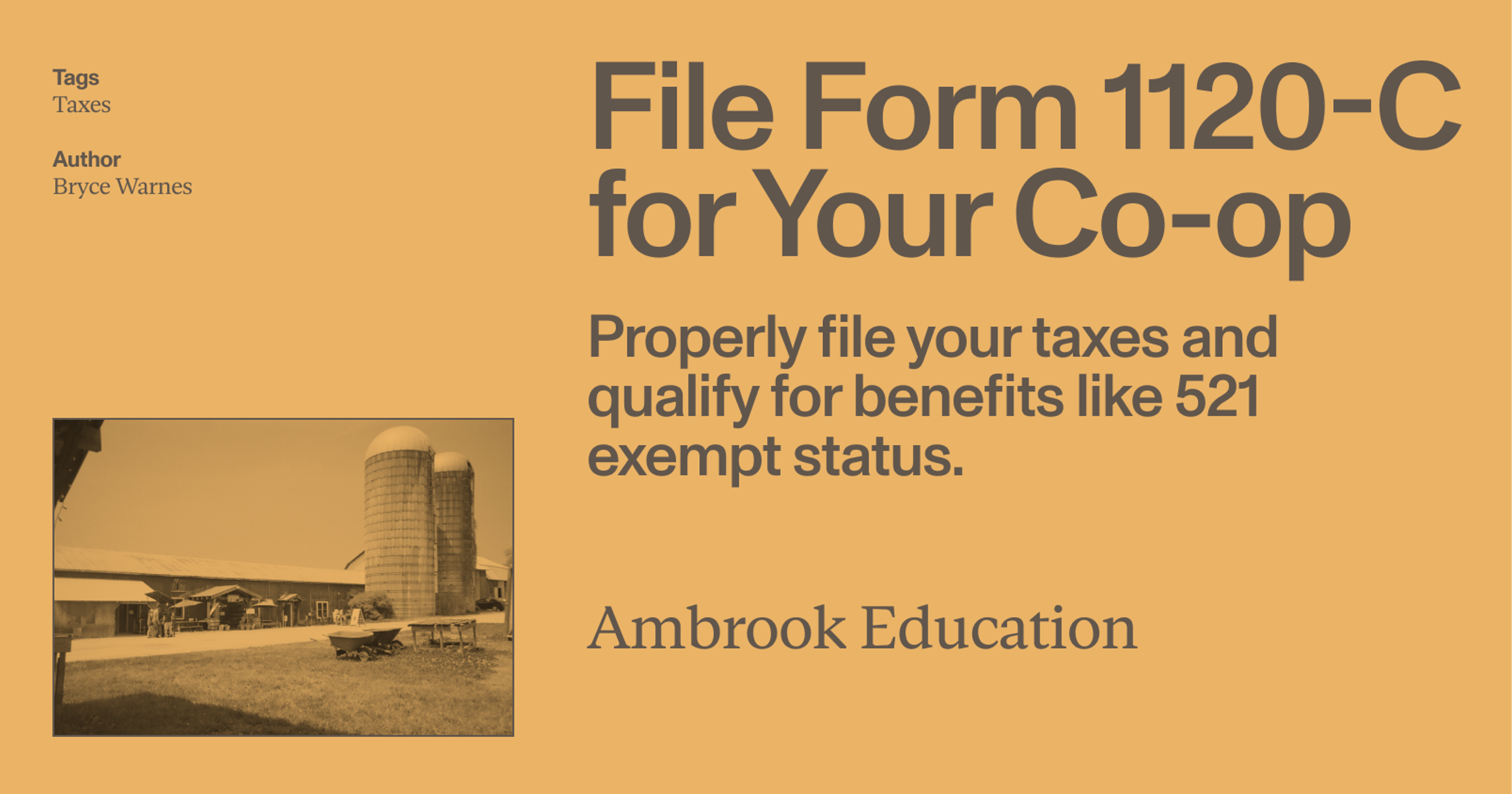Succession planning is about much more than “handing over the keys.” It has huge tax implications for retiring agricultural producers and their successors.
Tax burdens are often one of the greatest obstacles to a smooth and successful operation. Delaying tax decisions often leads to fewer options, higher bills, and costly mistakes. Without careful planning, capital gains, self-employment taxes, and estate or inheritance taxes can erode the very assets your family has spent generations building. But when approached proactively, tax strategy becomes a powerful tool.
In this guide, we’ll help you understand and leverage key tax strategies that can help protect your operation and ensure your legacy continues as you prepare to pass your business on to the next generation.
Factors to consider beforehand
Families or operations often wait too long to start planning for succession–until a health crisis or retirement, for example. At that point, tax strategy options are limited and decisions tend to be rushed.
Before looking at any specific tax issues, it’s important to ask yourself and anyone else involved in the succession process a few important questions:
How many years remain before the transition takes place?
Can the business and/or family absorb higher taxes if necessary?
Is the current owner prepared to incur taxes now to ease the burden later?
Are the successors financially ready to take on ownership?
Also, address any outstanding tax issues upfront, such as past monetized installment sales under IRS code section 453A, which defer taxes on income by selling agricultural products through installment agreements, spreading income over time.
Key tax strategies:
1. Capital gains tax planning
Capital gains taxes apply to appreciated assets such as land, livestock, or equipment. Succession planning can help minimize capital gains through timing transfers during low-income years, structuring sales to reduce realized gains, or using a step-up in basis at the time of inheritance.
2. Choose the right business structure
Overlooking the benefits of entity structuring–especially if the goal is to keep the operation running past the current generation–is a common mistake in succession planning. Operations miss out on key liability protections and tax efficiencies, such as strategic ownership transfers or gifting options over time.
Structuring your business as a sole proprietorship, partnership, LLC or C corporation has implications for the way it is taxed. It affects how income, self-employment, and estate taxes are applied.
LLCs, sole proprietorships and partnerships are considered pass-through entities, which means their profits pass directly through to their owners, who report and pay taxes on that income on their personal tax returns.
With C corporations things can get a bit more complicated. They can result in double taxation, once at the corporate level, and again when corporate earnings and any dividends are passed on to shareholders. Furthermore, transferring land into or out of a C corporation can trigger capital gains unless carefully planned.
3. Step-up in basis
One of the most powerful tools in succession planning is the step-up in basis, which allows heirs to reset the inherited assets to their fair market value at the date of the decedent’s death.
This means the heir’s cost becomes the current market value, not what the original owner paid for it. For assets that appreciate in value like land, it can mean a big decrease in capital gains taxes. Note that this strategy is most effective with inherited assets and not assets gifted during the owner’s lifetime.
Step-up in basis applies to sole proprietorships, partnerships, and trusts on assets. For S corporations and C corporations, it applies to stock only. In the case of an LLC, it depends on the structure and tax election.
4. Reduce self-employment tax
Active farm and ranch income is generally subject to self-employment tax. As producers transition out of daily operations, reducing or restructuring earned income can lower your tax liabilities, especially in retirement. Some key strategies include:
Shift to passive income:
Use cash rent or crop share leases, because rental income from land is not subject to self-employment tax.
Rent machinery along with land as a package deal, which can shift income from active to passive.
Convert from active operator to landlord via long-term leases, which reduces self-employment tax exposure. (Landlords can maintain ownership and cash flow while passing operational control to the next generation.)
Non-cash & deferred income:
Payment-in-kind (PIK) wages, such as compensating labor with goods instead of cash.
Trading in used equipment for new may defer taxable gains.
Gifting unsold grain to charities or individuals, which removes the income from your return.
5. Succession via equity sale
Selling equity–such as ownership interests in an LLC or partnership or shares in a corporation–to a successor rather than gifting or selling individual assets can provide a smoother transition and potential tax advantages.
For partnerships and LLCs, the seller is generally taxed on the capital gain from the sale of their interest. In the case of the buyer, with a properly executed §754 election they can deduct depreciable assets at an accelerated rate, receive more favorable tax deductions sooner, and gain amortization benefits that reflect the fair market value of the operation.
For C corporations, sellers of corporate stock are taxed on capital gains. Unfortunately, buyers do not receive a step-up in basis on the corporation’s assets and get no depreciation benefits. A common strategy is to discount the transaction value to reflect poor tax treatment for the buyer.
Estate, inheritance & gift tax strategies
Federal and state estate and inheritance taxes can significantly reduce the value of the operation being transferred. Without proper planning, heirs could be forced to sell off parts of the operation to cover the tax bill. But with thoughtful strategies, including the use of trusts, gifting, and conservation tools, farming and ranching families can minimize or even eliminate these tax burdens.
1. Estate vs. inheritance taxes
Estate tax is levied on the total value of an estate before it is distributed to heirs. The current federal exemption as of 2025 is $13.61 million per individual. Something to keep in mind is that even if your operation is under the current federal threshold, land appreciation, equipment value, and livestock inventory can push the estate over the exemption in future years.
Inheritance tax is levied on the heir, not the estate. It only applies in a handful of states–Iowa, Nebraska, Kentucky, Maryland, New Jersey, and Pennsylvania. Rates vary based on the relationship to the deceased.
2. Using trusts
Different types of trusts offer benefits from a legal, tax, and managerial perspective.
The main benefit of grantor trusts (aka revocable living trusts) is that they simplify probate proceedings by transferring assets outside of court. Unfortunately, they do not offer much of a tax advantage because the assets are still included in the taxable estate, but they are ideal for simplifying estate administration.
Irrevocable trusts are utilized once assets are transferred and the grantor no longer owns or controls them, thus ultimately removing them from the taxable estate.
Generation-skipping trusts skip a generation to reduce estate tax exposure twice. This can be very useful when grandchildren are primary heirs or part of a long-term generational operation.
Special needs trusts protect assets for heirs with disabilities without affecting their tax eligibility for public assistance programs.
Marital & family trusts help spouses take full advantage of both individual estate tax exemptions. One trust benefits the surviving spouse, while the other holds the remaining assets for heirs.
Charitable remainder trusts allow you to donate land or other assets, receive a tax deduction, and retain income from the asset for life, then pass the remainder to a nonprofit or land trust.
Asset protection trusts keep assets shielded from creditors and lawsuits and are useful for high-liability operations.
3. Gifting strategies
A lifetime gifting strategy is a way to reduce the taxable estate while also giving heirs a head start. Timing matters when it comes to gifting land and assets.
The annual gift exclusion per recipient as of 2025 is $18,000.00. Gifts above this amount reduce the lifetime estate exemption and must be reported to the IRS. Gifts under this amount do not count against the lifetime exemption.
Lifetime gifts retain the original cost (carryover basis), which can lead to high capital gains taxes if heirs decide to sell. Inherited assets receive a step-up in basis to the fair market value at the time of death. This often results in minimal capital gains if/when sold.
4. Using conservation easements
For working operations or preservation-minded landowners, using conservation easements can lower the taxable estate’s value while allowing owners to maintain operational control. While an easement places permanent restrictions on development or use, it reduces land value, thus decreasing the estate’s tax exposure.
Safeguard your operation from unnecessary taxes
By combining practical tools–like entity structuring, gifting, and leasing–with long-term mechanisms like trusts and conservation easements, you can reduce tax exposure while aligning your plan with the operation’s values and goals. With the right strategy, you’re not just avoiding tax pitfalls—you’re building a tax-smart bridge between generations. Proactive planning ensures that your land, business, and legacy are preserved, not diminished over time.
Streamline farm and ranch taxes with Ambrook
Ambrook’s Schedule F category tags are tailor-made for agriculture, saving you hours of work during tax season and making it easy to double-check your records for potential deductions. With features like automated financial reporting, simplified bookkeeping, and effortless bill pay and invoicing, Ambrook is more than just a farm tax and accounting tool: it takes the guesswork out of running your business.
Want to learn more? Start your 7 day free trial today.
This resource is provided for general informational purposes only. It does not constitute professional tax, legal, or accounting advice. The information may not apply to your specific situation. Please consult with a qualified tax professional regarding your individual circumstances before making any tax-related decisions.







